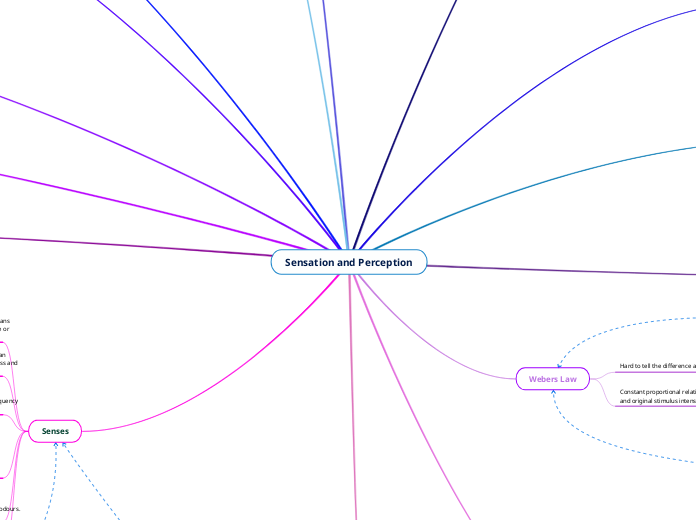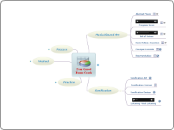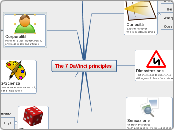Both of these processes are related to sight. Accomodation
refers to the eyes adjusting to light, whereas opponent process deals with what colours a person sees in.
The cycle theory states that every experience someone has
a process and response, while webers law proves the differences in knowing frequencies. These coincide because you would use cycle when you hear a type of frequency and webers law to understand and discern it.
To notice when a stimuli has entered your absolute threshold
you must pay attention and have some sort of focus to understand why you are sensing what you are sensing and how it affects you.
The accodmodation process involves adapting to
stimuli (light) when our eyes go into a new setting.
Psychologists in the signal detection theory can use this theory to understand how and why our eyes need to adjust to different light settings.
Illusion and signla detection theory can coincide with
each other. Illusion involves the sense organs transmitting
misleading information to the brain, while signal detection theory helps psychologists determine how we detect stimuli under incertain conditions. Signal detection theory can identify the stimuli that causes the senses to transmit misleading information.
Parallel processing helps our minds remember the past
and what was there a moment ago. Subliminal persuasion
has to do with people being made to behave or act as a result from a subliminal message. Subliminal persuasion could lead to parallel processing being needed.
Our senses can sometimes trick us. There are times
where we see something that is not there or hear something that's not around. Illusion deals with the senses on some level with stimulation or overstimulation of the senses.
The sense are so important because we as humans cannot
perceive the wolrd without our senses. Our senses have everything to do with how we perceive the physical world and if we do not pay attention to them then things will go unoticed. What we perceive depends on where our attention is.
Webers Law dicusses how we tell ghe difference
in freqencies and the relationship with stimulus intensities
while the absolute threshold discusses how any sense we experience involved our absolute threshold. Both of these topics discuss the differences in frequencies and how the senses effect us.
Psychophysics and Cycles are paired because
psychophysics study how we understand sensory stimuli, while cycle involves sensory input with processing and responses. Psychophysics studies us while cycle explains it.
Sensation and sensory memory are connected because
the brain remembers every sensation we come accross
and keeps it as sensory input from everything that surrounds us.
These topics are connected because
sensation and perception coincide. Sensation is
physical while perception is mental. When you touch something, your brain tells you how it feels.
Sensation and Perception
Attention
What drives attention: External force, novelty and
familiarity (meaning, ditchotomic), emotional (personal)
Automatized experiences: Used to doing something so you
repeat it.
Multi tasking v.s task shifting
Selective attention: Purposeful focusing
of conscious awareness on a specific stimulus or
event in the environment to the relative exclusion
of other stimuli and events.
What you are perceiving right now depends
greatly on where your attention is
Senses
Smell and memory - Highly associated. Process
of smell near hippocampus.
Taste and smell - Olfactory bulbs in the nose sense odours.
Taste buds found on tongue.
Touch - Skin has 3 distinct layers. 1. Epidermis, 2. Dermis, 4. Hypodermis. Skin is resiliant and waterproof. Also, the largest organ in the human body.
Hypodermis : Deeper layer, thick, insulating cushion
Dermis : Contains line cells, nerve endings
Epidermis : Outer layer, regenerates every
28 days
Hearing - Sound has two main components (Frequency
and amplitude)
Amplitude: Describes volume measured in decibels.
Frequency: Describes pitch (low
or high) measured in hertz.
Sight - Humans derive more info from sight than
any other senses. The eyes take in light, process and
transmits.
Any of the faculties by which humans
or animals take in info from inside or
outside the body
Illusion
4 types of illusion: 1. ambiguous illusions 2. distorting/geometrical optical illusions 3. paradox illusions or fictions
Illusions use the way our brains work to perceive
the world around us
When any of the sense organs "transmit misleading information of the brain"
After effects of the stimulation or overstimulation
of the senses
The process involving an interaction of logical and empirical considerations
Signal detection theory
Developed to help psychologists determine
how we detect stimuli under uncertain conditions
Accomodation process
Changes the lenses shape to focus light onto the back
of the eyes allowing us to adapt to different
light conditions
Opponent process
We perceive colour as either red or green or as
either blue or yellow
Subliminal persuasion
Does NOT drive attention
Argues that we can be made to behave or act in
a particular way as a result of a mesage presented
at the subliminal level
Parallel processing
Our minds build up perception by piecing together
what is in the sensory field and what was there a moment ago
as well as what we remember from our past
How we can attend to many sense modalities
simultaneously
Sensory memory
Everything in our memory begins as sensory input
from our environment.
Role: Take the information coming into the brain
through sensory receptors and hold it until
a decision is made about what to do with it.
99% of all sensory information is discarded almost
imediately upon entering the brain
People do not perceive a lot of what they see
Transduction: Process of conveting an external energy
or substance into a neural activity
Absolute threshold
The smallest level of stimulus that can be
detected usually defined as at least
half the time.
The second you hear, see or feel something it has
entered your absolute threshold.
Deifference threshold:
Tell the difference in what you
see, hear and feel.
Webers Law
Constant proportional relationship between the JND
and original stimulus intensity
Hard to tell the difference at higher frequencies
Lower - Easier
Example: Car volume - 10-15 sounds
like a much bigger difference than 25-30
Cycle: Think, Pair, Share
Situation: If you see a car driving towards you, you move
out of the way. Take cycle, map it onto what you know
Response is generated, sensory receptors are stimulated,
and sensory information is orgaized and interpreted,
stored and related to previous experiences.
Every experience you have, there's sensory input
processing and response. The brain gives
interpretive structure
Psychophysics
Fun fact: Some dogs have 220 million or more olfactory receptors compared to 5 million for humans.
The study of how we percieve sensory stimuli based on physical characteristics
Perception
The brains interpretation of raw sensory input.
Sensation
The detection of physical energy by sense organs and perception









